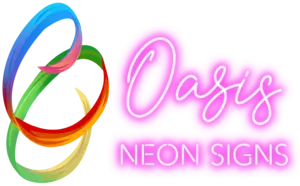
Neon vs LED: Difference Between Neon Signs and LED Signs
Share
As a business owner looking for a signage company, how can you decide between neon vs LED to use for your business? Neon and LED signs are the two most popular types of signs on the market. This merely describes the kind of lighting that a sign employs. In the future, LED signs will replace the more than century-old neon signage. Avoid becoming distracted by pretentious sales tactics or unclear lingo. Signs made of LEDs or neon are very striking. Nevertheless, depending on the category, one is preferable to the other.
In this blog post, we go into full details of what both signs have to offer. We have also outlined a side-by-side comparison of both signs, so you understand better the difference between neon vs LED signs.
Neon Sign Explain
One very resilient and effective light bulb is neon signs. It resembles fluorescent lighting quite a bit. When comparing neon vs fluorescent lighting, both use gas-discharge tubes, but differ in their gas compositions, colors, and energy efficiency. Fluorescent gas-discharge tubes, shaped in diverse ways, are heated, and bent to construct them.
Neon signs that were customized were popular from the 1920s through the 1960s. In addition to some of the lighter pink tints, neon signs are visible in the following colors: violet, yellow, green, blue, and white. The hues are produced by argon gas combined with a mercury drop. The atoms light up in response to an electric current flowing through the electrodes of the tube.
How Do Neon Lights Work?
The way neon signs produce light is via the chemical reaction of the gas inside the glass tube with the energy input through the metal electrodes. These signs are composed of glass tubes filled with neon gas and shaped like letters or beautiful patterns. An electrical current of high voltage is passed through the gas, causing the neon tubing to light up.
LED Signs Explain
The phrase "Light-Emitting Diode," or LED, describes a type of gadget that emits light. Those tiny individual LEDs are grouped in a substantial plastic framework that can be shaped into any desired shape. It can even be trimmed to the exact length you require for your company's sign. The electricity consumptions between neon signs vs LED signs are different but not something crazy like people may think. More about that below!
How Do LED Signs Work?

LED neon produces a reaction when electrons flow through a semiconductor, usually a substance called aluminum-gallium-arsenide, as opposed to neon, which depends on a reaction involving the neon gas and electricity. When there are too many LEDs in one area, they will use more electricity and may even create hot spots, which are areas where the light is too bright and looks to be dotted. Black spots will result from an improperly spaced LED set that is too small. Positioning the LEDs to create a continuous light source that resembles neon gas blazing within a glass tube is essential.
Neon vs LED Lights Comparison
Each have their benefits and drawbacks, but a few key distinctions between the two are as follows:
Adaptability
Signage and other options are the ideal uses for neon lights. The flashing effect they provide while lighting is the primary reason why many prefer them. Some desire a smooth and consistent signage choice. This is the perfect use for LED neon lights. LED neon signs can also be utilized to light automobile interiors, stores, under cabinets, and other spaces.
Energy Efficiency
Neon lights often require a lot of electricity to facilitate the electrons' separation from the atom and the production of light. Your lights won't function if there is not enough electricity being consumed or if the power fluctuates. Conversely, LED neon uses a small amount of energy to operate. Additionally, they are resistant to power fluctuations and won't melt or flicker.
Setup
Given that neon lights are composed of glass tubes, which make them extremely delicate, installation requires extra caution and patience. But glass neon vs LED neon signs are a different story. If you follow the directions, installing them is simple and uncomplicated. It is possible to bend them because of their increased flexibility.
Lifespan
Neon lights are guaranteed to last for 30,000 hours before they start to malfunction. But LED neon lights guarantee brilliant performance for 100,000 hours and well-lit applications. Select the best option after considering the duration you want your lighting to last.

Eco-friendliness
There has always been a concern regarding the environmental aspects of neons as they contain various gases and glass tubes. To prevent accidents and the release of hazardous gases into the atmosphere, damaged neon lights must be disposed of. LED lights emit no toxic emissions and are environmentally benign.
Maintenance
Comparing neon lights to LED neon lights, neon lights demand far more care. To keep the lights operating as efficiently as possible, the noble gases inside the glass tubes must be changed regularly. Both the regular cleaning of the glass and the integrity of the phosphor-coating of gases must be guaranteed. LED neon just must be cleaned; it is not required. To guarantee that they are safe from damage, they are packaged in silicone covers. As a result, less work is required for upkeep.
Accuracy of design
The flexibility of LED neon lights makes it simple to achieve specific designs. These lights are easily bendable to apply various fonts, make complicated messages, and create logos. Eventually, anyone can make custom DIY neon signs by shaping the LED strips into desired design and securing them onto a sturdy acrylic or wooden backing.
The glass tubes become less flexible when exposed to neon light. Even if they can produce identical designs, their precision will differ. The level of detail achieved by LED neon lights surpasses that of neon lights. The lighting frequency of a neon tube is 360° around the glass tubing, while LED strips only emit light at 220°.
Light alteration
Neon lights cannot have their color changed once they are made. It's convenient to have control over the lighting show while using LED neon lights. Simple programming and light-communication drives are included with the LED lights. It is particularly attractive because of the control over the colors, brightness, and dimming effect, among other characteristics.
Sturdiness
Once constructed, neon tubes are established and stiff, however, imitation LED neon can bend, become frail, or maintain a rigid straight line.
Color selections
Whether neon gas or argon/mercury gas is used to pump the neon tube, around 50 different colors are available. About five colors are available for LED strips.
Which Sign Is Better?

There are various types of neon signs, and there is no one-size-fits-all answer to which is better. The best choice depends on your specific needs and preferences.
Below, we look at how they will help your unique needs.
For business
When it comes to neon signs vs LED signs, several variables are included in the use of the sign, its size, and the location of installation.
The following factors are important for businesses:
- Attracting attention - Without a doubt, LED lights are more visible and brighter than glass tube neon signs; in contrast, the latter's light is noticeably softer and more pronounced after dark.
- Aesthetics and curb appeal - The two types of signs are effective in drawing attention. In terms of appearance, neon has a big advantage over LED flex, which is true for some kinds of stores considering its cult following.
- The need for space: Though not a problem for every company, tiny shops or cafés might choose LED because it is between one-third and one-fourth as thin as glass. Additionally, they are incredibly lightweight and may be easily wall-mounted, hung from anywhere, or set over the counter.
- Energy efficiency: Since LED signs may be up to 10 times kinder to the environment than a similar sign made of glass neon tubes, it is the obvious choice in this situation.
- Total cost: When considering maintenance, replacement prices, expert installation requirements, longevity, neon sign repair costs, and other factors, LED is always the most economical choice.
- Security: Glass neon signs heat up and are brittle. LED lights don't even get hot—they're wrapped in flexible plastic and typically mounted on an acrylic backboard that won't break.
For indoor arts
The home bars of individuals who own glass neon signs are the exception rather than the rule. For instance, a glass tube neon sign would be extremely uncommon in a children's room. This is because glass neon is heavy, breakable, and may grow warm. LED neon imitation neon signs, on the other hand, are cool to contact and resistant to breaking. They are a safer alternative for use at home because they are devoid of both mercury and glass. LED signs are a better choice for indoor wall art, even if you don't have to worry about small children because they're lightweight, simple to install, and don't require an electrician.
Conclusion
The choice between neon vs LED for your house or company comes down to personal style. To make an informed choice, consider both of their primary benefits as well, but in the end, you should decide which is superior. It's unlikely that a sign you buy will provide whatsoever to your consumers if it doesn't even tempt you to buy it. When you look at the advantages of neon signs vs LED signs, rather than choosing based on price or effectiveness, it's generally advisable to explore what you find most appealing in terms of design and your business needs.

